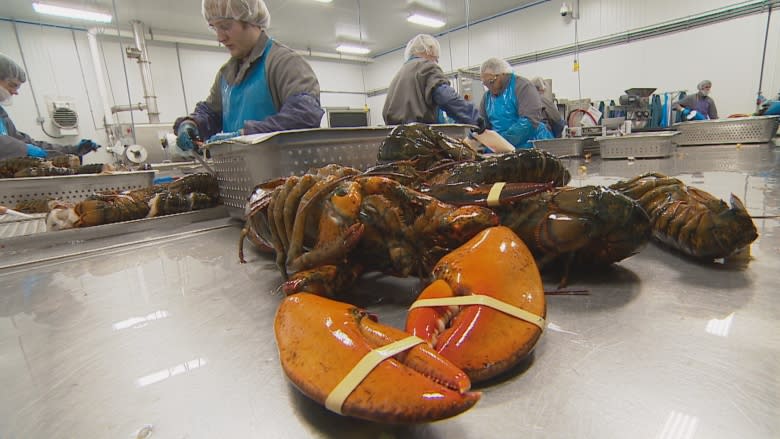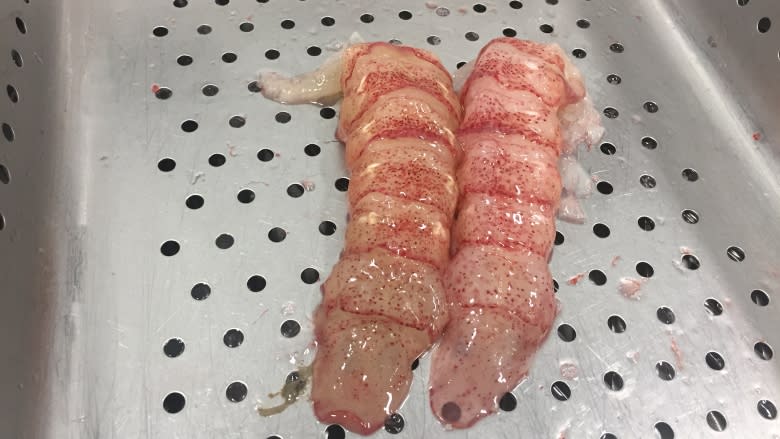Amid uncertain NAFTA future, lobster industry looks to other markets
U.S. President Donald Trump is known to be a steak kind of guy. But his threat to throw out the North American Free Trade Agreement is lending a whole new meaning to "surf and turf" for at least one lobster-processing plant in southwestern Nova Scotia.
"Yes, we all watch the negotiations. Yes, we're all concerned about what will happen," said Robert MacDonald, president and general manager of Gidney Fisheries in Centreville, N.S.
The U.S. is the largest consumer of lobster from the Maritimes, accounting for close to three-quarters of the roughly $2 billion this country exported in 2016, according to the Department of Fisheries and Oceans.
But with the future of the free trade deal up in the air, MacDonald said his industry is facing some uncertainty.
"There's stability in having an agreement in place and the knowledge that you know your products are going to be priced appropriately," he said.
The U.S. will remain an important market for Nova Scotia lobster no matter what happens at the ongoing trade talks.
Trade delegations from Canada, the U.S. and Mexico are wrapping up a week of meetings Friday, though the next formal round of negotiations is set for Montreal in early 2018.
Turning to tech
MacDonald's company processes 15,000 lobsters a day that need to find a market. So he — and others like him — aren't waiting to find out how the talks go.
"Perhaps it may want to bring you to refocus your efforts on international markets, not to be so dependent on a single entity or market," he said.
That's exactly what Gidney Fisheries is doing. To help find and grow new markets, the company is turning to technology not commonly found in the fish-processing business: high-pressure processing.
The large, gunmetal grey machine used includes a special chamber that looks a little like a torpedo.
Live lobsters are placed in the chamber, where 87,000 pounds per square inch of pressure instantly kill the crustaceans. At the same time, the pressure constricts the lobster meat and pushes it free of the shell.
The lobsters that have undergone high-pressure processing are then manually shucked, resulting in meat that easily comes out in a raw, pristine and almost gelatinous state.
"We add no ingredients or preservatives. The product is vacuum-sealed and then flash-frozen with C02.… It's completely raw and lets the chefs cook it to the texture they prefer," said MacDonald.
This value-added, higher-profit product is landing on more dinner plates at five-star restaurants around the world.
Emerging markets
It's trade agreements that are helping Gidney Fisheries land those sales.
The Comprehensive Economic and Trade Agreement, Canada's new trade deal with the European Union, has already slashed tariffs on live lobsters by eight per cent. Tariffs will soon drop on frozen lobster, too. As a result, Gidney Fisheries expects to see a bump in sales.
The U.S., meanwhile, doesn't have such a deal with Europe.
MacDonald said he's in favour of trade agreements, especially when it means opening up more markets for his company.
"We saw a significant bump in our exports to Korea last year when the final tariffs came off of our live lobsters — that's been sustained business for us," he said. "That was a result of a well-negotiated trade agreement."
China is another burgeoning market for Maritime lobsters. It has quickly become the No. 2 importer of Canadian lobster, MacDonald said.
He said he'd love to see a free trade deal with that country someday, something currently in the "exploratory discussions" phase.
But for MacDonald, the lesson remains simple: in an era of uncertainty over the future of NAFTA, it's best to diversify.




